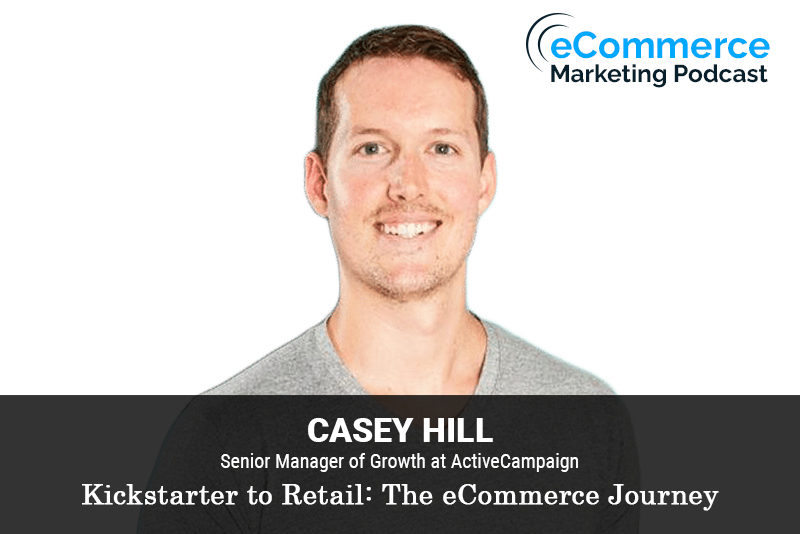
The eCommerce Marketing Podcast walks you through everything that goes into ecommerce marketing — from inbound marketing to paid advertising to conversions. Learn the strategies top marketing experts use to grow their businesses.
Casey Hill is currently the Senior Manager of Growth at ActiveCampaign
In this episode, you will learn
How crucial is authenticity in product reviews and video testimonials and the shift in consumer trust towards user-generated content versus polished brand-generated content
Key strategies to transition from a highly-funded Kickstarter campaign to sustainable long-term sales
How can eCommerce brands maintain their momentum when shifting from crowdfunding platforms to Direct-to-Consumer sales
What marketing adjustments should businesses make as they transition from crowdfunding to D2C, and eventually to retail
What are the top considerations for an eCommerce brand looking to make a successful leap into retail outlets
Based on the current trends and your experience in growth strategies, what is the next big shift or opportunity for eCommerce businesses, and how can they best prepare for it
For show transcript and past guests, please visit https://www.ecommercemarketingpodcast.com
Or on YouTube at:
https://www.youtube.com/channel/UC3PgT0NOGzpdPGQtBK0XLIQ
Follow Arlen:
Twitter: https://twitter.com/askarlen
Facebook: https://www.facebook.com/arlen.robinson.7
Instagram: https://www.instagram.com/arlenyohance/
LinkedIn: https://www.linkedin.com/in/arlenrobinson/
Past guests on the ecommerce marketing podcast include Neil Patel, Nemo Chu, Luke Lintz, Luke Carthy, Amber Armstrong, Kris Ruby and many more.
Thanks for listening. Be sure to subscribe and leave a review.

In this episode of the eCommerce Marketing Podcast, host Arlen Robinson interviews Casey Hill, the Senior Manager of Growth at ActiveCampaign. Casey shares his extensive experience in software, e-commerce, and content marketing, providing valuable insights on taking an e-commerce business from initial crowdfunding to direct-to-consumer (D2C) sales and eventually into retail. He emphasizes the importance of building organic growth channels and leveraging practical strategies to sustain long-term success.
Key Takeaways
- Introduction and Background ([00:03] – [02:41])
- Casey’s journey in the software and e-commerce space.
- His diverse experience in marketing automation, CRM, consulting, and teaching.
- Crowdfunding Strategies ([02:55] – [05:04])
- Importance of building a list before launching a Kickstarter campaign.
- Using local gaming stores for playtest sessions to gather contacts and drive initial momentum.
- Transition from Crowdfunding to D2C ([05:40] – [12:35])
- Asking for consent to contact Kickstarter backers post-campaign.
- Strategies for sustaining long-term sales, including podcast guesting, review sites, content series, and attending events.
- Navigating Competitive Ad Spaces ([09:28] – [10:28])
- Challenges of relying solely on paid ads in a competitive market.
- Importance of focusing on organic growth channels to maintain profitability.
- Retail Strategies ([14:07] – [16:54])
- Starting with small local stores before targeting big-box retailers.
- Creating a pipeline to nurture relationships with potential retail partners.
- Tracking and following up with interested retailers to secure long-term partnerships.
- Scaling to Big-Box Retail ([19:59] – [22:09])
- Building relationships with procurement representatives at large retailers.
- Importance of strong sales data and restocking metrics to demonstrate demand.
- Subscription E-commerce and Influencer Marketing ([23:56] – [30:51])
- Growth potential in subscription e-commerce for stability and recurring revenue.
- Leveraging authentic influencer partnerships for effective marketing.
- Focusing on micro-influencers for higher engagement and cost-effectiveness.
- Final Thoughts and Fun Fact ([31:48] – [34:51])
- Casey’s unique journey from cold pitching a university to teaching content marketing.
- Encouraging proactive outreach and leveraging practical experience for success.
Guest Info
Casey Hill
Senior Manager of Growth at ActiveCampaign
LinkedIn: Casey Hill
Email: [email protected]











